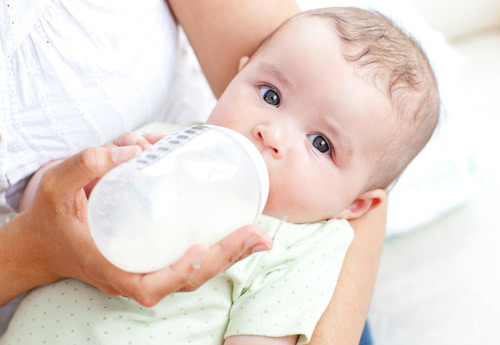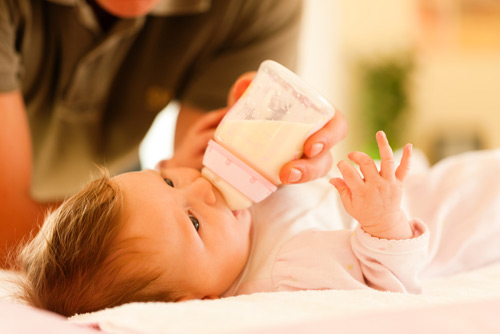Bottle Feeding

Reasons For Bottling Your Breast Milk
Some reasons for introducing a bottle of expressed breast milk are working outside the home, going back to school or simply because you may need to run an errand or go to an afternoon wedding.
Some moms have the flexibility to take their baby along or to be gone just long enough so they can breastfeed before leaving and as soon as they return. But sometimes the situation may call for expressed breast milk. That's why it's good to know that your baby can be fed the way you want, no matter how your schedule pans out. Just know that delays can - and will - happen (and you want to be prepared), so even stay-at-home moms may find it helpful to introduce breast milk from a bottle.
Guidelines For Feeding Your Baby Breast Milk
| AGE | AVERAGE AMOUNT PER FEEDING |
|---|---|
| Birth - 1 Week | 2-3 fl. oz. |
| 1 Week - 1 Month | 2-4 fl. oz. |
| 1 - 3 Months | 4-5 fl. oz. |
| 3-6 Months | 6-7 fl. oz. |
| 6-9 Months | 7-8 fl. oz. |
| 9-12 Months | 7-8 fl. oz. |
Storing Breast Milk For Healthy, Full-Term Infants
In refrigerator:
FRESHLY EXPRESSED BREAST MILK
- Use within 24 hours if possible
- Store milk in back of main body of refrigerator in plastic or glass bottle with sealable top or in a sterile, sealable bag in amounts used on a daily basis (ex. 4 ounces)
- Can stay in refrigerator for 48 hours (39 F or 4 C)
PREVIOUSLY FROZEN BREAST MILK
- 24 hours
In freezer:
FRESHLY EXPRESSED BREAST MILK
- Label and use oldest first
- Store in back of freezer (lower quality may result from milk stored for longer durations)
- Store in plastic or glass bottle with sealable top or in a sterile, sealable bag in amounts used on a daily basis (ex. 4 ounces)
- Can stay in a home freezer for 3 months and in a -4 F or -20 C freezer for 12 months
PREVIOUSLY FROZEN BREAST MILK
-
Never refreeze
Tip: Label your supply with the number of ounces prior to freezing because breast milk expands after it freezes.
Tips To Thaw Out Frozen Breast Milk
| DO | DO NOT |
|---|---|
| Thaw container of frozen breast milk gradually in the refrigerator, under increasingly warm running water, or in a bowl of warm water. | Defrost container of breast milk by using boiling or very hot water. |
| After the thawing is complete, gently swirl the container to mix the milk before feeding it to the baby because the milk may separate while standing. | Defrost container of breast milk in a microwave oven. Uneven heating may cause "hot spots" that could burn your baby. Also, microwaving may alter proteins and destroy some protective components of the milk. |
Any Questions About Breastfeeding?
Does my baby need to eat anything else besides breast milk?
No, your baby shouldn't need to eat anything else besides breast milk, unless it is recommended by your doctor for medical reasons. The American Academy of Pediatrics, however, suggests all infants and children receive 400 IU of vitamin D daily beginning soon after birth and continuing throughout childhood to strengthen their overall bone health. But make sure to check with your doctor before making changes to your baby's diet.
What kind of diet is good to follow while I'm breastfeeding?
For women who are breastfeeding, an ideal diet includes a well-balanced variety of healthy foods including dairy products, fruits, vegetables and proteins. Most women can maintain a healthy milk supply while taking in at least 1800-2200 calories per day. It's helpful to minimize the amount of empty-calorie foods and eat more nutrient-rich foods. A good rule is to listen to your body, which will guide you in getting the calories you need. It's also important to talk to your doctor about vitamins and including iron in your diet. The vitamins can make up for any deficiencies that may be in your diet.
When you're breastfeeding, you're still eating for two. If you notice that your baby becomes upset after some feeding, it may be because of something you ate. If this happens, you should talk with your doctor to come up with a plan of action; however, no one food or food group should be eliminated from your diet unless your baby has a very clear reaction to a specific food.
Can I lose weight if I breastfeed my baby?
Ah, the craving for the pre-baby body. While we don't recommend crash diets or over exercising, you can lose weight while breastfeeding - in fact, it will probably happen naturally.
Breastfeeding often helps a mother get back to her pre-pregnancy weight for two reasons. First, the hormones involved in breastfeeding help the uterus shrink back to the size it was before you became pregnant. Second, you have a certain little someone helping you burn extra calories. If you are worried about your diet, encourage yourself to eat healthy foods, which will increase your energy while providing nutritious milk for your baby. Also, many moms find that frequently eating small, nutritious snacks and meals and drinking plenty of fluids help them fight flab.
Aching to bust a move to bust your gut? Go right ahead. Breastfeeding mothers can begin exercising as soon as their doctors give them the a-okay.
I know that I'm going to have to go back to work. How can I continue to give my baby breast milk while I'm away?
Your baby can still have breast milk if you express (commonly called pump) your breast milk for bottle feedings. Also, many businesses have established lactation programs to help support breastfeeding mothers when they return to work. You might want to check with your employer to see what is available to help ease the stress of working and breastfeeding.
Can you give me some information about expressing breast milk?
We suggest using a breast pump or hand expression. Hospital-grade electric pumps with double collecting systems provide the closest imitation of your baby's sucking action and are a great option if you will be pumping on a regular basis. If you're only going to be separated from your baby occasionally, a hand pump should do fine.
What can I do to get Dad involved?
Get him to cook, clean and slave away! Just kidding. (Well, sort of). The truth is, studies have shown that with a father's support, breastfeeding is more successful and continues for a longer period of time. To start, Dad can be your cheering squad. Not hands-on enough? Dad can also prepare meals, help around the house, and if you're expressing milk, take a turn and bottle-feed, which will allow him to bond with baby. All told, Dad's help can give you a much-needed break, not to mention give your home a more positive environment.

Content Provided by Similac
Choosing Nipples & Bottles
Your local grocery stores and pharmacies will carry a variety of nipples. Some may be easy for your baby to suck, but may also allow too much milk too quickly. Latex nipples will hold their integrity better if your baby sucks hard, while silicone nipples are transparent and easy to keep clean. We recommend buying a few different types to find out what your baby likes best. Glass bottles are still available, and these last a lot longer than plastic bottles. However, they may also pose a hazard when your baby is older and strong enough to drop and shatter them.

Tips For Handling & Mixing Formula
- If using cans of formula, check the expiration dates and wash the top of a can before opening.
- If you're using liquid concentrate or powder, adhere to the mixing directions on the can. (Formula that's too thick or thin can make baby sick.)
- To warm the formula, set the bottle in a pan of warm water or an electric bottle-warmer.
- Avoid the microwave ovens. Microwaves overheat the formula, destroy nutrients, and cause hot spots that could burn baby's mouth and throat.
- Before feeding, pour some onto your wrist to test the temperature. The formula should be warm, not hot.
- Don't allow formula to sit for more than 30-minutes at room temperature, and don't save leftover formula that remains in the bottle. These could make your baby sick.
- Follow directions on the formula for keeping open, mixed, unused formula in the refrigerator. Most will instruct you to throw it away within 48 hours.
Bottle-Feeding Tips
- Your baby will need to eat every 2 to 4 hours. Start with 1/2-ounce at each feeding and gradually increase as tolerated.
- Shake the bottle and test the liquid's temperature on your wrist before feeding. Make sure formula is warm, not hot.
- Tip the bottle until formula fills the neck of the bottle & the nipple.
- Baby's tongue goes under the nipple, and nipple is toward the back of the mouth.
- Burp your baby after 1/2 to 1 ounce of formula. How often your baby needs to burp depends on how fast your baby drinks and how much air is swallowed.
Bottle And Nipple Cleaning Tips
- Wash the bottles and nipples in hot soapy water.
- Make sure the nipple holes are cleaned well. (Replace nipples when they become soft, sticky, tacky or discolored.)
- Rinse well with hot water.
- Let the bottles and nipples air dry.
- Do not store clean nipples and bottles in an air-tight container. Small amounts of milk could remain on them and cause mold.
Formula
Formulas come in ready-to-drink, powder, and liquid concentrate forms. The most convenient of these is powder, as it does not need to be refrigerated until mixed. (It is also the least expensive). If you have well water in your home, use bottled water for a minimum of 6-months. It's ok to use tap water in the city, as this will give your baby fluoride, but please run the water for at least 2-minutes to flush any deposits or residue from your pipes. Ready-to-use is the most expensive, but it can be helpful when traveling, or at other times when mixing is problematic.
 PREGNANCY
PREGNANCY  GIVING BIRTH
GIVING BIRTH  BABY CARE
BABY CARE  HEALTH & SAFETY
HEALTH & SAFETY  FUN STUFF
FUN STUFF  FAMILY
FAMILY 